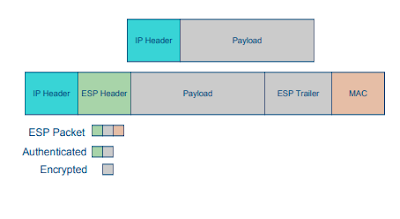Introduction Computer and Network Security.
Network Security
Idea :
- Why don’t we just integrate some of these neat crypto tricks directly into the IP protocol stack?
- This is called transport security.
IPsec
- P layer security protocol
– Integrated directly into protocol stack– Defined as an extension to the network layer– Transparent to the above layers and application
- Provides
– confidentiality– integrity– authenticity– replay protection– DOS protection
- Transport mode
– default mode of IPsec -- protects transport layer packet
– end-to-end encapsulation of data
– useful when both endpoints are configured to use/manage IPsec
- Tunnel mode
– encapsulates all of the IP data over a new IP level packet
– useful when the device applying IPsec to the packet is not the originating host, e.g., at a gateway
– Also known as, “ip over ip”
• IPsec provides the mechanism, you provide the policy
IPsec Processing
- Built on of ISAKMP framework
- Two phase protocol used to establish parameters and keys for session
- ISAKMP keys
– Phase 2: Establish a security association (SA)
- SA keys used to process user traffic
- The details are unimaginably complex
- The SA defines algorithms, keys, and policy used to secure the session
IPsec Implementation
- User: ISAKMP framework
- Kernel: IPsec processing
Authentication Header (AH)
- Authenticity and integrity
– via HMAC– over IP headers and and data
- Advantage: the authenticity of data and IP header information is protected
– it gets a little complicated with mutable fields, which are supposed to be altered by network aspacket traverses the network– some fields a immutable, and are protected
- Confidentiality of data is not preserved
- Replay protection via AH sequence numbers
– note that this replicates some features of TCP (good?)
Authentication Header (AH)
- Modifications to the packet format
- SPI: (spy) identifies the security association for this packet
– Type of crypto checksum, how large it is, and how it is computed
– Really the policy for the packe
- Authentication data
– Hash of packet contents include IP header as as specified by SPI– Treat transient fields (TTL, header checksum) as zero
- Keyed MD5 Hash is default
- Confidentiality, authenticity and integrity
– via encryption and HMAC– over IP payload (data)
- Advantage: the security manipulations are done solely on user data
– simplifies processing– TCP packet is fully secured
- Use “null” encryption to get authenticity/integrity only
- Note that the TCP ports are hidden when encrypted
– good: better security, less is known about traffic– bad: impossible for FW to filter/traffic based on port
- Cost: can require many more resources than AH
Encapsulating Security Payload (ESP)
Some argue that AH is subsumed by ESP
– Header protection can be achieved by tunnel mode ESP– Protection of header has limited utility
- Should we allow firewalls (and eavesdroppers) to look at layer 4 (TCP) information
– e.g., filter on ports– exposes a lot of information
- In practice, the protocol AH is generally not used.
IPsec Tunnel Mode
- Encapsulate IP packet
- IPsec implementations
– Often not compatible (ungh.)– Large footprint
- resource poor devices are in trouble
- New standards to simplify (e.g, JFK, IKE2)
– Slow to adopt new technologies
- Issues
– IPsec tries to be “everything for everybody at all times”
- Massive, complicated, and unwieldy
– Policy infrastructure has not emerged
– Large-scale management tools are limited (e.g., CISCO)
– Often not used securely (common pre-shared keys)
Network Isolation: VPNs
- Idea: I want to create a collection of hosts which operate in a coordinated way
– Hosts work as if they are isolated from malicious hosts– E.g., a virtual security perimeter over physical network
- Solution: Virtual Private Networks
– Create virtual network topology over physical network– Use communications security protocol suites to secure virtual links “tunneling”– Manage networks as if they are physically separate– Hosts can route traffic to regular networks (split-tunneling
VPN Example: RW/Telecommuter
VPN Example: Mesh
- VPNs build with hardware
– “wire based isolation”– No encryption – none needed– Allows networks to be reorganized without rewiring– Switches increasingly support VLANs
- Example usage: two departments in same hallway
– Each office is associated with department– Configuring the network switch gives physical isolation– Note: often used to ensure QoS
.png)












